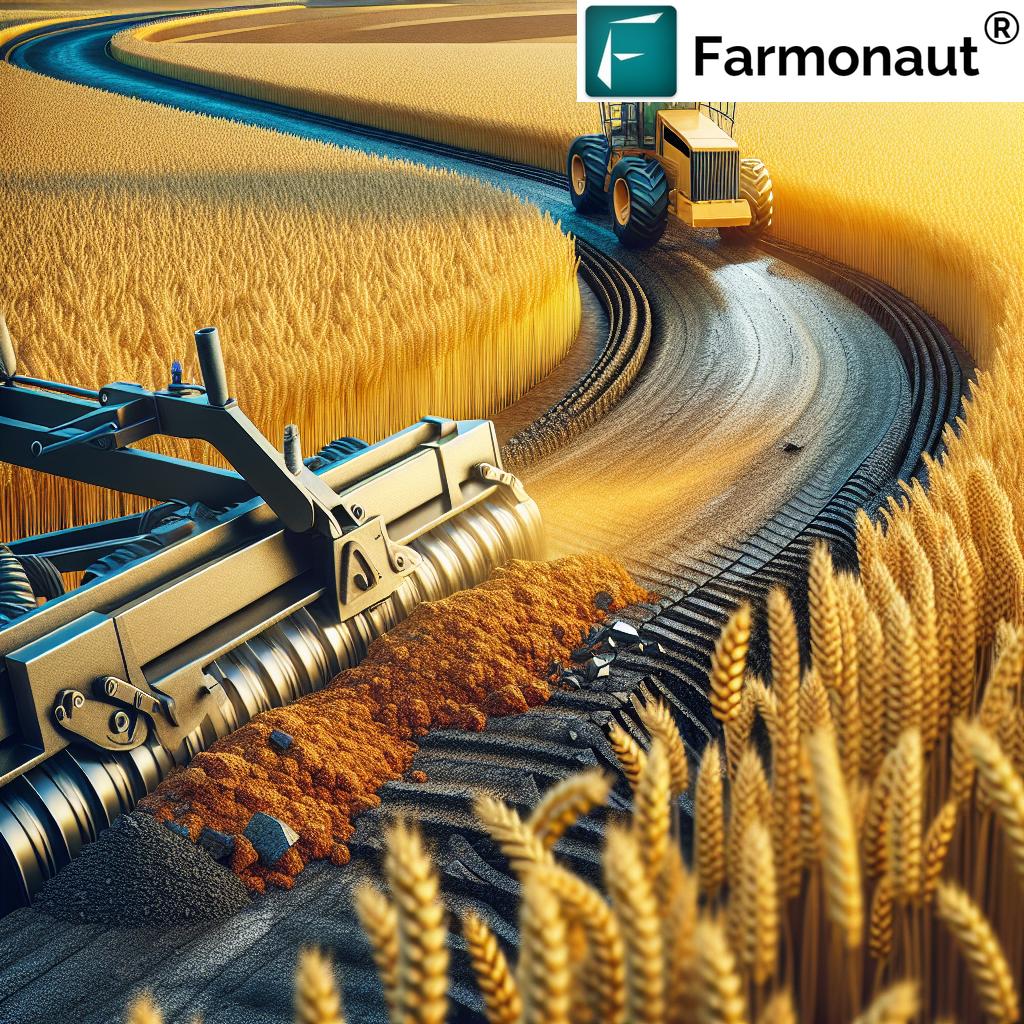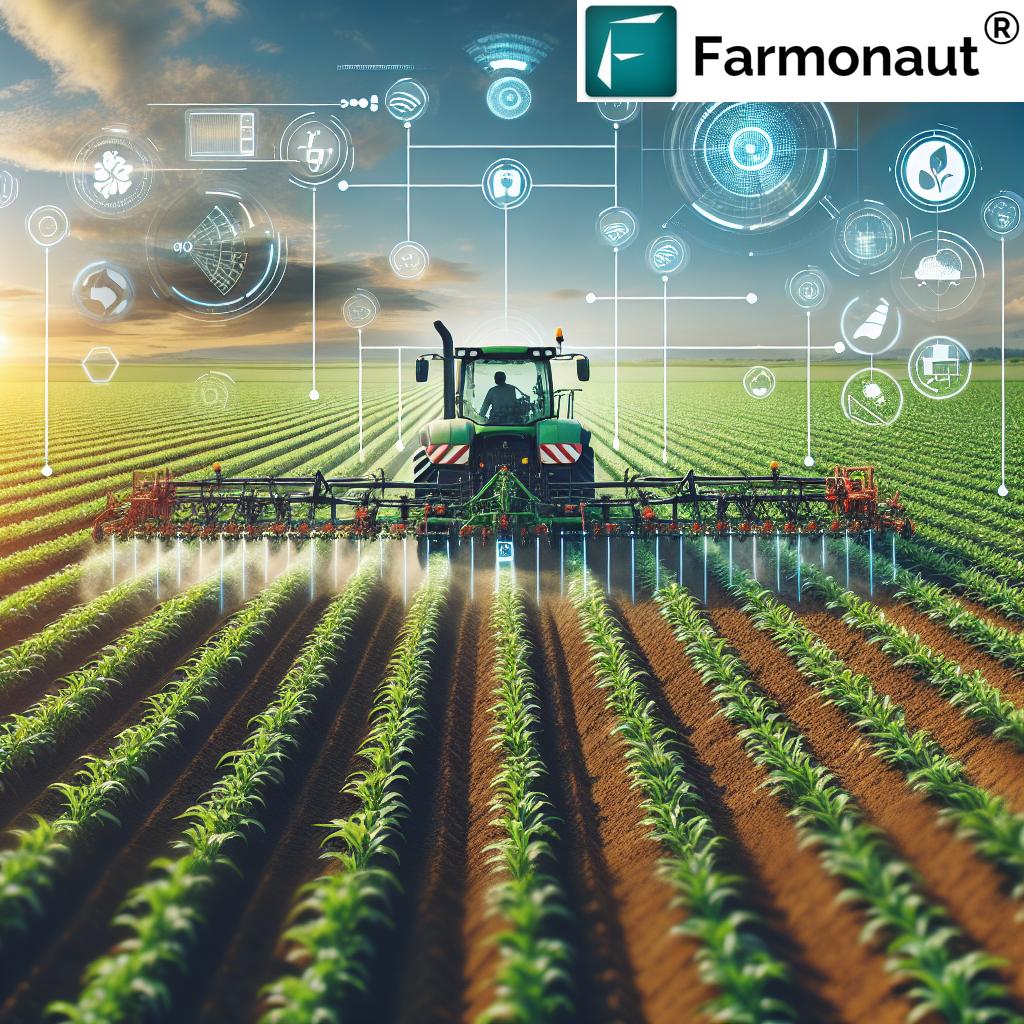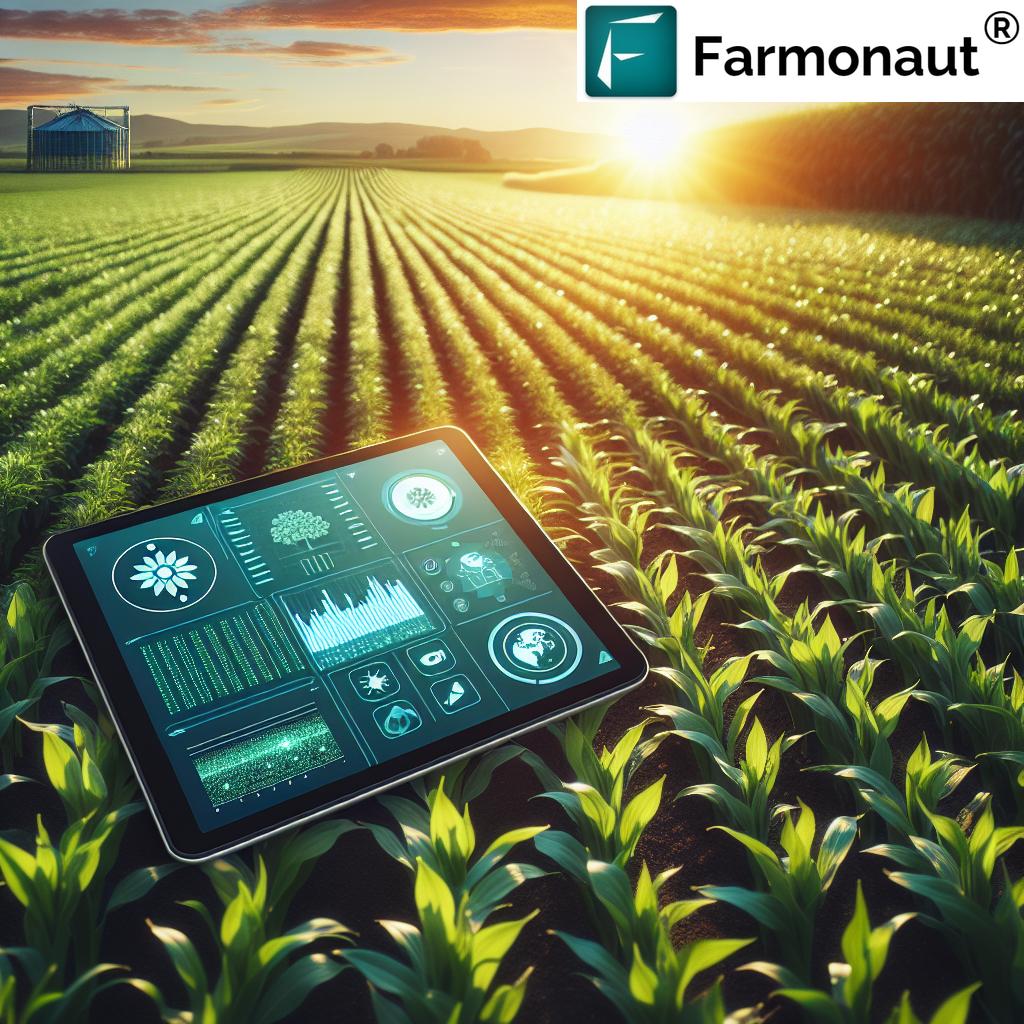Mastering Flax Cultivation: A Comprehensive Guide to Boost Yield and Optimize Production with Precision Agriculture
“Flax plants typically go through 5-7 distinct growth stages from germination to harvest, each requiring specific care.”
Welcome to our comprehensive guide on mastering flax cultivation! In this article, we’ll explore the intricacies of growing flax, from seed selection to harvesting, and how modern precision agriculture techniques can revolutionize your flax farming practices. Whether you’re a seasoned farmer or new to flax cultivation, this guide will provide you with valuable insights to enhance your agricultural productivity and optimize flax production.
Understanding Flax: A Versatile and Valuable Crop
Flax (Linum usitatissimum) is a versatile crop known for its fiber and oil-producing capabilities. With a rich history dating back thousands of years, flax has been cultivated for both its strong fibers used in textiles and its nutrient-rich seeds, which are pressed to produce flaxseed oil. Today, flax remains an important agricultural commodity, with applications in various industries, including textiles, food, and pharmaceuticals.
As we delve into the world of flax cultivation, it’s crucial to understand that successful flax farming requires a combination of traditional agricultural knowledge and modern precision agriculture techniques. By implementing the best practices outlined in this guide and leveraging advanced crop monitoring technology, such as that offered by Farmonaut, you can significantly increase your flax yields and improve overall crop quality.
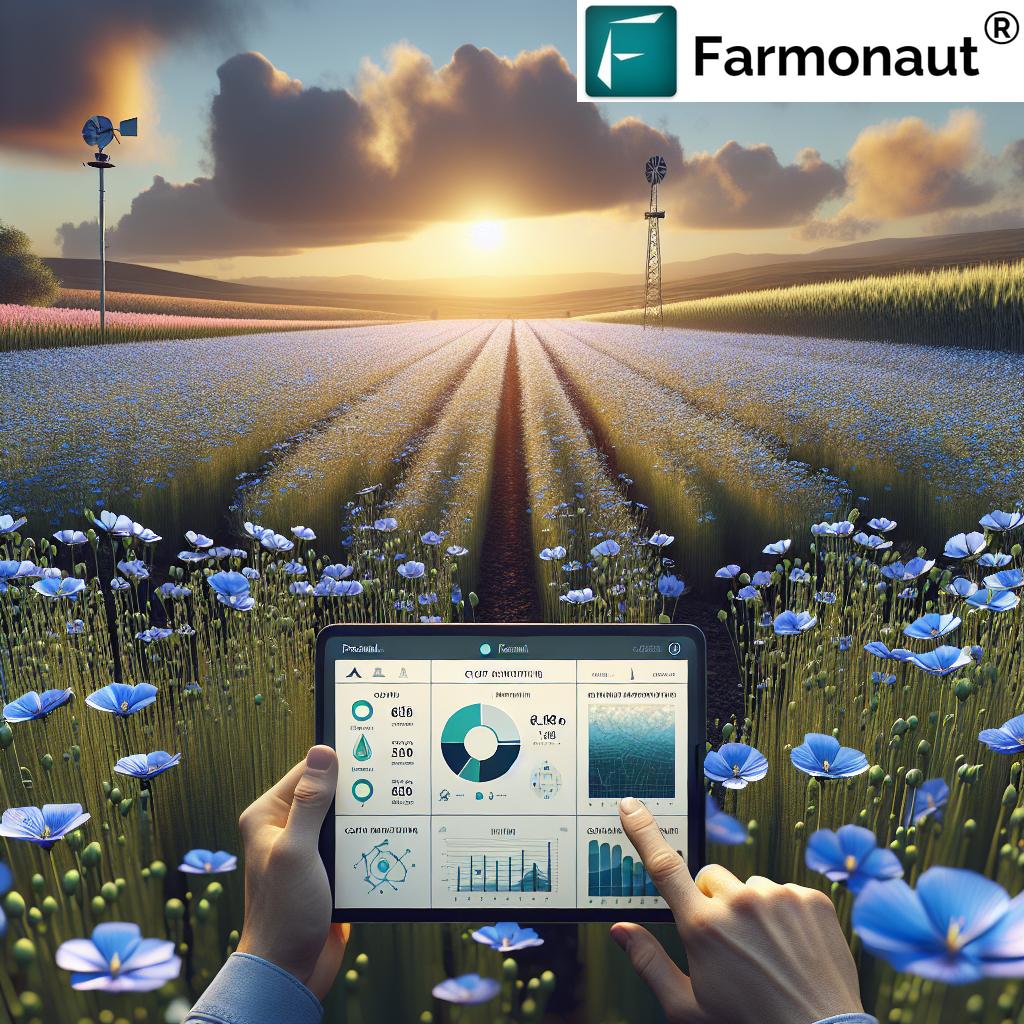
Soil Preparation: The Foundation of Successful Flax Cultivation
Proper soil preparation is crucial for optimal flax growth and development. Flax thrives in well-drained, fertile soils with a pH range of 6.0 to 7.5. Here are some key steps to prepare your soil for flax cultivation:
- Soil Testing: Conduct a comprehensive soil test to determine nutrient levels, pH, and organic matter content. This information will guide your fertilization and amendment strategies.
- Plowing and Tillage: Perform deep plowing in the fall to break up compacted soil layers and incorporate crop residues. Follow up with shallow tillage in spring to create a fine, firm seedbed.
- Nutrient Management: Based on soil test results, apply necessary fertilizers and amendments. Flax typically requires moderate levels of nitrogen, phosphorus, and potassium.
- Organic Matter: Incorporate organic matter, such as well-rotted compost or green manures, to improve soil structure and water retention capacity.
By using Farmonaut’s satellite-based soil moisture monitoring, you can gain valuable insights into your field’s moisture levels, helping you make informed decisions about irrigation and planting timing.
Selecting the Right Flax Varieties
Choosing the appropriate flax variety is crucial for success in your specific growing region. Consider the following factors when selecting flax seeds:
- Purpose: Determine whether you’re growing flax for fiber, oil, or both. Different varieties are optimized for specific end uses.
- Climate Adaptation: Select varieties that are well-suited to your local climate, considering factors such as growing season length, temperature extremes, and rainfall patterns.
- Disease Resistance: Look for varieties with resistance to common flax diseases in your area, such as fusarium wilt or rust.
- Yield Potential: Consider the yield history of different varieties in your region, as well as their performance under various management practices.
Consult with local agricultural extension services or seed producers to identify the best flax varieties for your specific growing conditions and production goals.
Flax Sowing Techniques and Best Practices
Proper sowing techniques are essential for establishing a healthy flax crop. Follow these guidelines to ensure optimal seed placement and germination:
- Timing: Sow flax seeds in early spring when soil temperatures reach 7-10°C (45-50°F). Early planting can help avoid heat stress during flowering.
- Seeding Rate: Aim for a seeding rate of 30-50 kg/ha (27-45 lbs/acre) for oil flax and 80-120 kg/ha (71-107 lbs/acre) for fiber flax.
- Planting Depth: Sow seeds at a depth of 2-3 cm (0.8-1.2 inches) in moist soil. Deeper planting may be necessary in drier conditions.
- Row Spacing: Use narrow row spacing of 15-20 cm (6-8 inches) for optimal plant density and weed suppression.
- Seed Treatment: Consider using fungicide-treated seeds to protect against seedling diseases and improve early vigor.
Farmonaut’s precision agriculture tools can help you optimize your sowing strategy by providing accurate weather forecasts and soil moisture data, ensuring ideal planting conditions for your flax crop.
Understanding Flax Growth Stages
Familiarizing yourself with the growth stages of flax is crucial for effective crop management. Here’s an overview of the key flax growth stages:
- Germination and Emergence: Seeds germinate and seedlings emerge within 7-10 days of planting, depending on soil conditions.
- Seedling Stage: Plants develop their first true leaves and begin photosynthesis.
- Vegetative Growth: Rapid stem elongation occurs, and plants develop a branched structure.
- Bud Formation: Flower buds appear at the tips of branches.
- Flowering: Blue flowers open and pollination occurs. This stage typically lasts 15-25 days.
- Boll (Seed Capsule) Development: Seeds form and mature within the bolls.
- Maturity and Senescence: Plants turn yellow and brown as they reach physiological maturity.
Understanding these growth stages is essential for timing management practices such as fertilization, pest control, and harvesting. Farmonaut’s crop monitoring technology can help you track your flax crop’s progress through these stages, providing valuable insights for decision-making.
Explore Farmonaut’s API for advanced crop monitoring
Nutrient Management for Optimal Flax Growth
Proper nutrient management is crucial for maximizing flax yield and quality. Here are some key considerations for fertilizing your flax crop:
- Nitrogen (N): Apply 40-80 kg/ha (36-71 lbs/acre) of nitrogen, depending on soil fertility and previous crop history. Avoid excessive N, which can promote lodging.
- Phosphorus (P): Apply 20-40 kg/ha (18-36 lbs/acre) of P2O5, based on soil test results. Phosphorus is crucial for early root development.
- Potassium (K): Apply 20-40 kg/ha (18-36 lbs/acre) of K2O if soil tests indicate low potassium levels.
- Sulfur (S): Flax has a high sulfur requirement. Apply 10-15 kg/ha (9-13 lbs/acre) of sulfur, especially on sandy soils or those low in organic matter.
- Micronutrients: Monitor and correct any deficiencies in zinc, boron, or manganese, which can impact flax growth and yield.
Farmonaut’s satellite-based crop health monitoring can help you identify areas of nutrient stress in your flax field, allowing for targeted fertilizer applications and improved nutrient use efficiency.
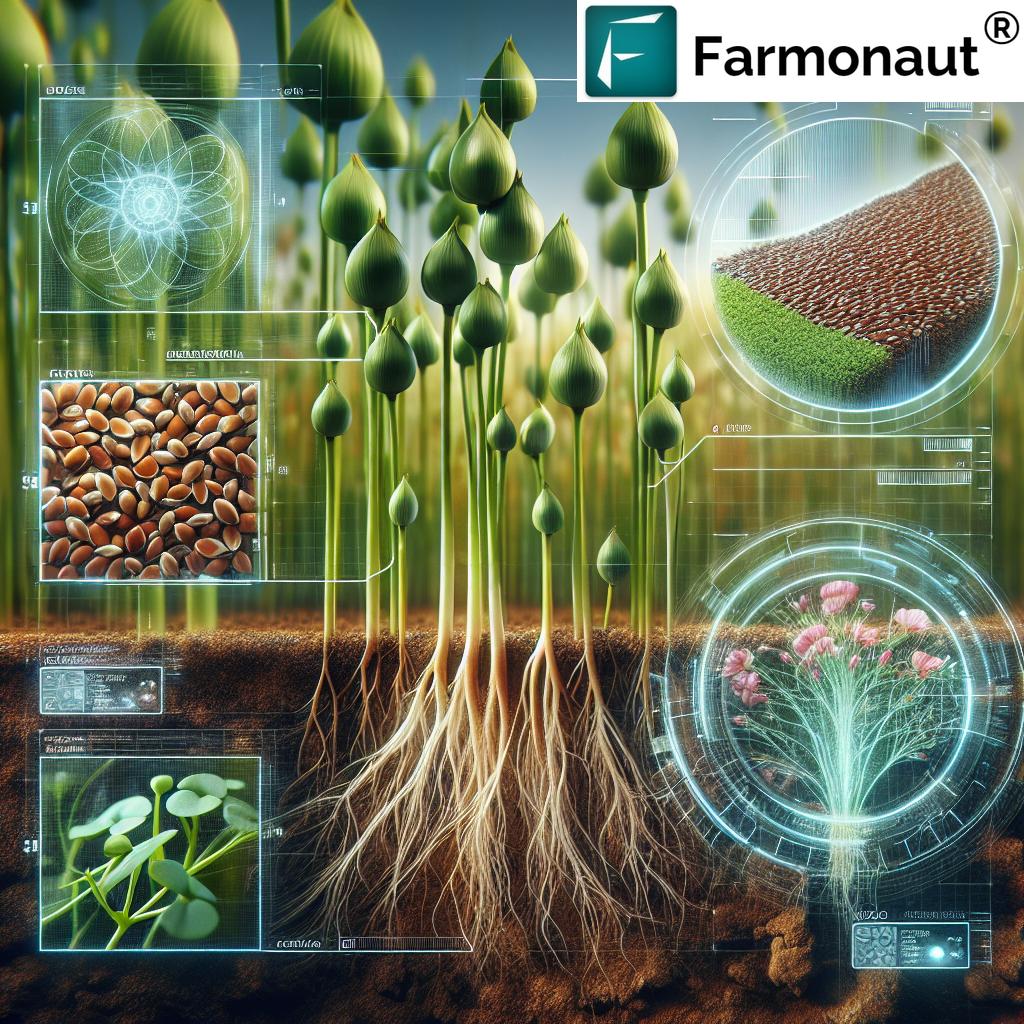
Water Management and Irrigation Strategies
While flax is relatively drought-tolerant, proper water management is essential for optimal growth and yield. Consider the following irrigation strategies:
- Soil Moisture Monitoring: Use soil moisture sensors or Farmonaut’s satellite-based soil moisture data to track water availability throughout the growing season.
- Critical Growth Stages: Ensure adequate moisture during critical growth stages, particularly during germination, early vegetative growth, and flowering.
- Irrigation Scheduling: If irrigation is necessary, apply water when the soil moisture content in the root zone drops below 50% of field capacity.
- Water Use Efficiency: Implement water-conserving practices such as mulching or conservation tillage to improve water retention in the soil.
Farmonaut’s precision agriculture tools can help you optimize your irrigation strategy by providing real-time data on crop water stress and soil moisture levels, enabling more efficient water use in your flax cultivation.
“Precision agriculture techniques can increase flax yields by up to 20% through optimized resource management and timely interventions.”
Pest and Disease Management in Flax Cultivation
Effective pest and disease management is crucial for maintaining healthy flax crops and maximizing yields. Here are some key strategies for managing common flax pests and diseases:
Pest Management
- Flea Beetles: Monitor for early-season damage and consider seed treatments or foliar insecticides if populations are high.
- Cutworms: Scout fields regularly and apply insecticides if cutworm populations exceed economic thresholds.
- Grasshoppers: Implement border spraying and use bait treatments to control grasshopper populations.
- Aphids: Monitor for aphid infestations, especially during flowering, and use insecticides if populations threaten yield.
Disease Management
- Fusarium Wilt: Use resistant varieties and practice crop rotation to reduce disease pressure.
- Rust: Plant rust-resistant varieties and apply fungicides if disease pressure is high.
- Pasmo: Implement proper crop rotation and consider fungicide applications at early flowering if disease risk is high.
- Seedling Blight: Use treated seeds and ensure proper planting conditions to minimize seedling diseases.
Farmonaut’s crop monitoring technology can help you detect early signs of pest infestations or disease outbreaks, allowing for timely interventions and more effective pest and disease management in your flax fields.
Access Farmonaut’s API Developer Docs for advanced crop monitoring integration
Weed Control Strategies for Flax
Effective weed management is crucial for maximizing flax yields, as flax is a poor competitor with weeds. Implement these strategies for successful weed control:
- Pre-planting Weed Control: Use tillage or herbicides to control existing weeds before planting flax.
- Narrow Row Spacing: Plant flax in narrow rows to promote rapid canopy closure and suppress weed growth.
- Pre-emergence Herbicides: Apply pre-emergence herbicides to control early-season weeds.
- Post-emergence Herbicides: Use selective post-emergence herbicides to control broadleaf and grassy weeds. Always follow label instructions and observe pre-harvest intervals.
- Mechanical Cultivation: Consider inter-row cultivation for organic production or as part of an integrated weed management approach.
- Crop Rotation: Implement a diverse crop rotation to break weed cycles and reduce weed pressure in flax fields.
Farmonaut’s satellite imagery can help you identify areas of weed infestation in your flax fields, enabling targeted weed control measures and improving overall crop management efficiency.
Harvesting and Post-Harvest Handling of Flax
Proper harvesting and post-harvest handling are critical for maximizing the quality and value of your flax crop. Follow these guidelines for successful flax harvesting:
Determining Harvest Readiness
- Monitor seed moisture content; ideal harvest moisture is 8-10% for oil flax and 12-14% for fiber flax.
- Look for visual cues such as brown bolls and yellowing stems.
- Use Farmonaut’s crop monitoring technology to track crop maturity and optimize harvest timing.
Harvesting Methods
- Direct Combining: Most common method for oil flax. Use a combine equipped with a pickup reel and adjust settings to minimize seed damage.
- Swathing: Useful in uneven ripening conditions or when weed pressure is high. Swath when 75% of bolls have turned brown.
- Pulling: Traditional method for fiber flax. Plants are pulled by hand or with specialized equipment to preserve fiber length.
Post-Harvest Handling
- Clean harvested seeds to remove debris and immature seeds.
- Dry seeds to proper storage moisture (8-9%) using low-temperature drying methods.
- Store flax seeds in clean, dry conditions to maintain quality.
By implementing these harvesting and post-harvest practices, you can ensure the highest quality flax crop and maximize your returns. Farmonaut’s precision agriculture tools can help you optimize your harvest timing and track crop quality throughout the post-harvest process.
Leveraging Precision Agriculture for Flax Cultivation
Precision agriculture techniques can significantly enhance flax production by optimizing resource use and improving decision-making. Here’s how you can leverage precision agriculture in your flax farming operations:
- Satellite-Based Crop Monitoring: Use Farmonaut’s satellite imagery to track crop health, detect stress, and identify variability within your flax fields.
- Variable Rate Technology (VRT): Implement VRT for fertilizer and pesticide applications based on field variability maps generated from satellite data.
- Weather Monitoring: Utilize Farmonaut’s weather forecasting tools to make informed decisions about planting, spraying, and harvesting operations.
- Soil Moisture Monitoring: Use satellite-based soil moisture data to optimize irrigation scheduling and improve water use efficiency.
- Yield Mapping: Create yield maps using GPS-enabled harvesting equipment to identify high and low-yielding areas for targeted management.
- Data-Driven Decision Making: Analyze historical and real-time data to make informed decisions about crop management practices.
By integrating Farmonaut’s precision agriculture tools into your flax cultivation practices, you can optimize inputs, reduce costs, and increase overall productivity and sustainability of your farming operation.
Sustainable Flax Farming Practices
Implementing sustainable farming practices in flax cultivation is essential for long-term soil health, environmental stewardship, and farm profitability. Consider the following sustainable approaches:
- Crop Rotation: Include flax in a diverse crop rotation to break pest and disease cycles, improve soil health, and optimize nutrient use.
- Cover Cropping: Plant cover crops after flax harvest to reduce soil erosion, improve organic matter content, and suppress weeds.
- Conservation Tillage: Implement reduced or no-till practices to conserve soil moisture, improve soil structure, and reduce erosion.
- Integrated Pest Management (IPM): Use a combination of cultural, biological, and chemical control methods to manage pests and diseases sustainably.
- Precision Nutrient Management: Use soil testing and precision agriculture tools to apply fertilizers only where and when needed, reducing nutrient runoff and improving efficiency.
- Water Conservation: Implement water-saving irrigation techniques and use Farmonaut’s soil moisture monitoring to optimize water use.
By adopting these sustainable practices and leveraging Farmonaut’s precision agriculture technology, you can improve the long-term sustainability and profitability of your flax farming operation.
Flax Cultivation Timeline and Best Practices
| Growth Stage | Timeframe | Key Activities | Precision Agriculture Applications |
|---|---|---|---|
| Soil Preparation | Fall – Early Spring |
– Soil testing – Deep plowing – Nutrient application |
– Soil mapping – Variable rate fertilizer application |
| Planting | Early Spring |
– Seed selection – Seed treatment – Sowing |
– Weather forecasting – Soil moisture monitoring |
| Early Growth | 2-4 weeks after planting |
– Weed control – Pest monitoring |
– Satellite-based crop health monitoring – Early stress detection |
| Vegetative Growth | 4-6 weeks after planting |
– Fertilizer application – Disease monitoring |
– Variable rate nutrient application – Crop stress mapping |
| Flowering | 6-8 weeks after planting |
– Irrigation management – Pest control |
– Irrigation scheduling – Pest hotspot identification |
| Seed Development | 8-10 weeks after planting |
– Disease management – Moisture monitoring |
– Disease prediction models – Soil moisture tracking |
| Harvesting | 10-12 weeks after planting |
– Harvest timing – Equipment preparation |
– Yield prediction – Harvest optimization |
Frequently Asked Questions (FAQ)
-
Q: What is the ideal soil pH for flax cultivation?
A: Flax grows best in soils with a pH range of 6.0 to 7.5. -
Q: How deep should I plant flax seeds?
A: Plant flax seeds at a depth of 2-3 cm (0.8-1.2 inches) in moist soil. -
Q: What is the average yield of flax?
A: Average flax yields range from 1,500 to 2,500 kg/ha (1,340 to 2,230 lbs/acre) for oil flax and 4,000 to 6,000 kg/ha (3,570 to 5,360 lbs/acre) for fiber flax. -
Q: How can precision agriculture improve flax cultivation?
A: Precision agriculture tools, such as Farmonaut’s satellite-based crop monitoring, can help optimize resource use, detect crop stress early, and improve overall yield and quality of flax crops. -
Q: What are the main diseases affecting flax?
A: The main diseases affecting flax include fusarium wilt, rust, pasmo, and seedling blight.
Conclusion
Mastering flax cultivation requires a combination of traditional agricultural knowledge and modern precision farming techniques. By implementing the best practices outlined in this guide and leveraging advanced crop monitoring technology like Farmonaut, you can significantly boost your flax yields and optimize production. Remember to adapt these guidelines to your specific growing conditions and continuously monitor and adjust your management practices for the best results.
As you embark on your flax cultivation journey, consider integrating Farmonaut’s precision agriculture tools into your farming operations. Our satellite-based crop monitoring, weather forecasting, and data analytics can provide valuable insights to help you make informed decisions throughout the growing season.
By combining your expertise with the power of precision agriculture, you can take your flax cultivation to new heights, ensuring sustainable and profitable farming for years to come.











